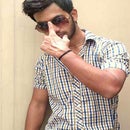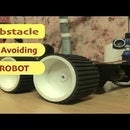Introduction: Gesture Controlled Mouse Using Python3.7 & OpenCV3+
It is a mouse simulation system which performs all the functions performed by your mouse corresponding to your hand movements and gestures. Simply speaking, a camera captures your video and depending on your hand gestures, you can move the cursor and perform a left-click, right-click, drag, select and scroll up and down. The predefined gestures make use of only three fingers marked by different colours.
Technical Overview
It is essentially a program which applies image processing, retrieves necessary data and implements it to the mouse interface of the computer according to predefined notions.
The code is written on Python3.7. It uses the cross-platform image processing module OpenCV and implements the mouse actions using Python-specific library PyAutoGUI. Video captures by the webcam are processed and only the three coloured fingertips are extracted. Their centres are calculated using the method of moments and depending upon their relative positions it is decided that what action is to be performed.
Step 1: Install Anaconda & Packages
★★★ Links ★★★
- How to Install Anaconda ➡️ click here
- How to install OpenCV ➡️ click here
- Python Tutorial Playlist ➡️ click here
Capture Video from Camera
Often, we have to capture the live stream with a camera. OpenCV provides a very simple interface to this. Let’s capture a video from the camera (I am using the in-built webcam of my laptop), convert it into grayscale video and display it. Just a simple task to get started. To capture a video, you need to create a VideoCapture object. Its argument can be either the device index or the name of a video file. Device index is just the number to specify which camera. Normally one camera will be connected (as in my case). So I simply pass (0 or -1). You can select the second camera bypassing 1 and so on. After that, you can capture frame-by-frame. But in the end, don’t forget to release the capture.
The first thing that we do is convert the captured video into HSV format.
code :
# All packages needed for the program are imported ahead
import cv2
cap = cv2.VideoCapture(0)
while(1):
# Capture frame-by-frame
_, frameinv = cap.read()
# flip horizontaly to get mirror image in camera
frame = cv2.flip( frameinv, 1)
# Our operations on the frame come here
hsv = cv2.cvtColor( frame, cv2.COLOR_BGR2HSV)
# Display the resulting frame
cv2.imshow('Frame', hsv)
k = cv2.waitKey(10) & 0xFF
if k == 27:
break
cap.release()
cv2.destroyAllWindows()Step 2: Calibrate Colour
Calibrate the colour ranges
Now the user gets to calibrate the colour ranges for three of his fingers individually. This is done by calling the calibrateColor() function thrice right at the beginning of the program. The user has an option to use the default settings as well.
Code :
import cv2
import numpy as np
def nothing(x):
pass
# Create a black image, a window
kernel = np.zeros((300,512,3), np.uint8)
name = 'Calibrate'
cv2.namedWindow(name)
# create trackbars for color change
cv2.createTrackbar('Hue', name, 0, 255, nothing)
cv2.createTrackbar('Sat', name, 0, 255, nothing)
cv2.createTrackbar('Val', name, 0, 255, nothing)
# create switch for ON/OFF functionality
switch = '0 : OFF \n 1 : ON'
cv2.createTrackbar(switch, name,0,1,nothing)
while(1):
cv2.imshow(name,kernel)
k = cv2.waitKey(1) & 0xFF
if k == 27:
break
# get current positions of four trackbars
hue = cv2.getTrackbarPos('Hue', name)
sat = cv2.getTrackbarPos('Sat', name)
val = cv2.getTrackbarPos('Val', name)
s = cv2.getTrackbarPos(switch,name)
if s == 0:
kernel[:] = 0
else:
kernel[:] = [hue,sat,val]
cv2.destroyAllWindows()Step 3: Remove Noise & Define Functions in the Video Feed
Depending on the calibrations, only the three fingertips are extracted from the video, one by one, using the cv2.inRange() function. In order to remove noise in the video feed, we apply a two-step morphism i.e. erosion and dilation. The noise filtered image referred to as mask in the program is then sent for locating the centres.
# cv2.inRange function is used to filter out a particular color from the frame # The result then undergoes morphosis i.e. erosion and dilation # Resultant frame is returned as mask def makeMask(hsv_frame, color_Range): mask = cv2.inRange( hsv_frame, color_Range[0], color_Range[1]) # Morphosis next ... eroded = cv2.erode( mask, kernel, iterations=1) dilated = cv2.dilate( eroded, kernel, iterations=1) return dilated
Step 4: Find Contours & Draw Centroids
Location of each of the three centres involves:
- Finding contours in the mask relevant to that colour range.
- Discarding contours of irrelevant areas using area filters.
- Finding the largest contour amongst the remaining ones and applying the method of moments to find its centre.
# Contours on the mask are detected.. Only those lying in the previously set area
# range are filtered out and the centroid of the largest of these is drawn and returned
def drawCentroid(vid, color_area, mask, showCentroid):
contour, _ = cv2.findContours( mask, cv2.RETR_TREE, cv2.CHAIN_APPROX_SIMPLE)
l=len(contour)
area = np.zeros(l)
# filtering contours on the basis of area rane specified globally
for i in range(l):
if cv2.contourArea(contour[i])>color_area[0] and cv2.contourArea(contour[i]):
area[i] = cv2.contourArea(contour[i])
else:
area[i] = 0
a = sorted(area, reverse = True)
# bringing contours with largest valid area to the top
for i in range(l):
for j in range(1):
if area[i] == a[j]:
swap( contour, i, j)
if l > 0 :
# finding centroid using method of 'moments'
M = cv2.moments(contour[0])
if M['m00'] != 0:
cx = int(M['m10']/M['m00'])
cy = int(M['m01']/M['m00'])
center = (cx,cy)
if showCentroid:
cv2.circle( vid, center, 5, (0,0,255), -1)
return center
else:
# return error handling values
return (-1,-1)
Step 5: Final Steps (Set Position, Choose & Perform Actions)
Then comes the step for defining the position of the cursor on the screen. The thumb, with yellow colour, is responsible for the position of the cursor. The following techniques have been used in this end:
- Generally, the webcams we use captures video at a resolution of 640x480 pixels. Suppose this frame was linearly mapped to the 1920x1080 pixel display screen. If we have a right-handed user, he would find it uncomfortable to access the left edge of the screen as compared to the right edge. Also accessing the bottom portion of the screen would build stress at the wrist.
- We realised that instead of mapping the whole video frame to the screen, we could rather consider a rectangular sub-portion more biased towards the right (considering right-handed user) and upper parts of the frame in order to improve comfort. This sub-portion which measures 480x270 pixels is then linearly mapped to the screen with a scaling factor of 4.
cursor[0] = 4*(yp[0]-110) cursor[1] = 4*(yp[1]-120)
- Due to noise captured by the webcam and vibrations in the hand, the centres keep vibrating around a mean position. On scaling up, these vibrations create a lot of problem with the accuracy of the cursor position. To reduce the shakiness in the cursor, we make use of differential position allocation for the cursor. We compare the new centre with the previous position of the cursor. If the difference is less than 5 pixels, it is usually due to noise. Thus the new cursor position is inclined more towards the previous one. However, a larger difference in the previous position and the new centre is considered as voluntary movement and the new cursor position is set close to the new centre. For details, go through the setCursorPosition() function in the code.
''' This function takes as input the center of yellow region (yc) and the previous cursor position (pyp). The new cursor position is calculated in such a way that the mean deviation for desired steady state is reduced. ''' def setCursorPos( yc, pyp): yp = np.zeros(2) if abs(yc[0]-pyp[0])<5 and abs(yc[1]-pyp[1])<5: yp[0] = yc[0] + .7*(pyp[0]-yc[0]) yp[1] = yc[1] + .7*(pyp[1]-yc[1]) else: yp[0] = yc[0] + .1*(pyp[0]-yc[0]) yp[1] = yc[1] + .1*(pyp[1]-yc[1]) return yp
Now the three centres are sent for deciding what action needs to be performed depending on their relative positions. This is done in the chooseAction() function in the code. Depending upon its output, the performAction() function carries out either of the following using the PyAutoGUI library:
PyAutoGUI library:
- free cursor movement
- left-click
- right-click
- drag/select
- scroll up
- scroll down
# Depending upon the relative positions of the three centroids, this function chooses whether # the user desires free movement of cursor, left click, right click or dragging def chooseAction(yp, rc, bc): out = np.array(['move', 'false']) if rc[0]!=-1 and bc[0]!=-1: if distance(yp,rc)<50 and distance(yp,bc)<50 and distance(rc,bc)<50 : out[0] = 'drag' out[1] = 'true' return out elif distance(rc,bc)<40: out[0] = 'right' return out elif distance(yp,rc)<40: out[0] = 'left' return out elif distance(yp,rc)>40 and rc[1]-bc[1]>120: out[0] = 'down' return out elif bc[1]-rc[1]>110: out[0] = 'up' return out else: return out else: out[0] = -1 return out
def performAction( yp, rc, bc, action, drag, perform):
if perform:
cursor[0] = 4*(yp[0]-110)
cursor[1] = 4*(yp[1]-120)
if action == 'move':
if yp[0]>110 and yp[0]<590 and yp[1]>120 and yp[1]<390:
pyautogui.moveTo(cursor[0],cursor[1])
elif yp[0]<110 and yp[1]>120 and yp[1]<390:
pyautogui.moveTo( 8 , cursor[1])
elif yp[0]>590 and yp[1]>120 and yp[1]<390:
pyautogui.moveTo(1912, cursor[1])
elif yp[0]>110 and yp[0]<590 and yp[1]<120:
pyautogui.moveTo(cursor[0] , 8)
elif yp[0]>110 and yp[0]<590 and yp[1]>390:
pyautogui.moveTo(cursor[0] , 1072)
elif yp[0]<110 and yp[1]<120:
pyautogui.moveTo(8, 8)
elif yp[0]<110 and yp[1]>390:
pyautogui.moveTo(8, 1072)
elif yp[0]>590 and yp[1]>390:
pyautogui.moveTo(1912, 1072)
else:
pyautogui.moveTo(1912, 8)
elif action == 'left':
pyautogui.click(button = 'left')
elif action == 'right':
pyautogui.click(button = 'right')
time.sleep(0.3)
elif action == 'up':
pyautogui.scroll(5)
# time.sleep(0.3)
elif action == 'down':
pyautogui.scroll(-5)
# time.sleep(0.3)
elif action == 'drag' and drag == 'true':
global y_pos
drag = 'false'
pyautogui.mouseDown()
while(1):
k = cv2.waitKey(10) & 0xFF
changeStatus(k)
_, frameinv = cap.read()
# flip horizontaly to get mirror image in camera
frame = cv2.flip( frameinv, 1)
hsv = cv2.cvtColor( frame, cv2.COLOR_BGR2HSV)
b_mask = makeMask( hsv, blue_range)
r_mask = makeMask( hsv, red_range)
y_mask = makeMask( hsv, yellow_range)
py_pos = y_pos
b_cen = drawCentroid( frame, b_area, b_mask, showCentroid)
r_cen = drawCentroid( frame, r_area, r_mask, showCentroid)
y_cen = drawCentroid( frame, y_area, y_mask, showCentroid)
if py_pos[0]!=-1 and y_cen[0]!=-1:
y_pos = setCursorPos(y_cen, py_pos)
performAction(y_pos, r_cen, b_cen, 'move', drag, perform)
cv2.imshow('Frame', frame)
if distance(y_pos,r_cen)>60 or distance(y_pos,b_cen)>60 or distance(r_cen,b_cen)>60:
break
pyautogui.mouseUp()Step 6: Demo
Download Code : Link






